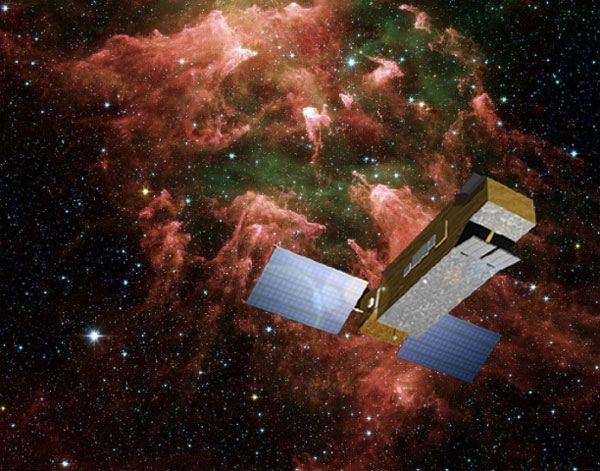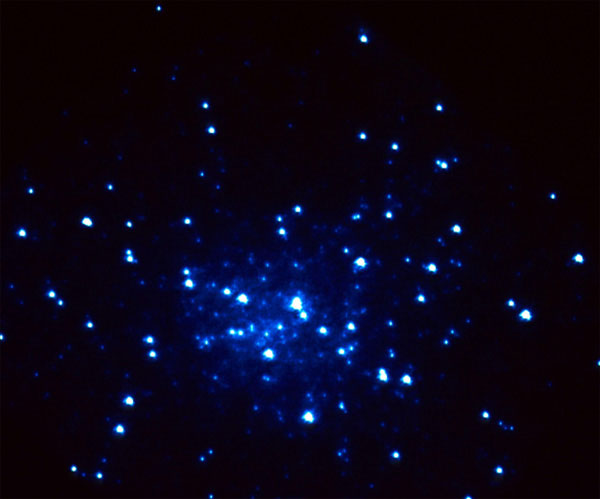Illuminating some mysteries of the cosmos with FUSE
- Launch: June 24, 1999
- Status: Mission completed
The history of the universe is written in the stars and we read that history by the light they emit.
One type of light-the far ultraviolet (UV)-is writing whole new chapters. Canadian scientists are using data from the Fair Ultraviolet Spectroscopic Explorer telescope (FUSE) satellite to read the stories told by the oldest and most exotic objects in the universe: white dwarfs, quasars and the hottest stars.
The significant thing about FUSE, which operated from 1999 to 2007, was that it probed a region of the electromagnetic spectrum that has been elusive in the past; it can't be seen by earth-based telescopes because the atmosphere filters out far ultraviolet (UV) radiation from space.

An illustration of the FUSE satellite on an infrared image of the Carina Nebula, a region of intense star formation which has been the subject of intense study by FUSE. (Credit: NASA)
The far UV is "a region of the spectrum that no other spacecraft or telescope can get," said John Hutchings, an astronomer with the Dominion Astrophysical Observatory (DAO) and Canadian FUSE project scientist. "You cannot reach it from the ground, you cannot reach it with the Hubble telescope or anything else. So these opportunities are rare and everybody scrambles when they're there."
Scientists are still trying to unravel what Hutchings calls "the history of everything," (the state of the early universe after the Big Bang occurred nearly 14 billion (B) years ago), and FUSE has provided some fascinating clues. He said the far UV is an "extremely rich part of the spectrum" that yields unique signatures of many exotic cosmic objects exhibiting extreme characteristics. "We're investigating physical conditions you cannot reproduce on Earth in anybody's laboratory. To understand these boundaries of physics, you've got to look somewhere else."

FUSE helped solve the mystery of why deuterium levels vary throughout the cosmos. In regions with a lot of interstellar dust, such as near the star AE Aurigae, deuterium can "stick" to dust particles where it cannot be detected. (Credit: T.A. Rector et B.A. Wolpa, NOAO, AURA et NSF)
FUSE was jointly built by National Aeronautics and Space Administration (NASA), the Canadian Space Agency (CSA) and France's Centre national d'études spatiales (CNES). Canada contributed the fine error sensors used to stabilize and point the telescope with extreme precision. In return, Canadian scientists got about 5 percent of the observing time on the telescope and participated in the international science team that directed the mission. To date, they've published about 17 percent of the scientific papers on the mission.
"This opened the doors to Canadians to participate in a prestigious mission that turned out to be extremely productive," said Jean Dupuis, CSA's program scientist in space astronomy.
Many of the Canadian researchers focussed on white dwarfs, the remnants of burnt-out stars. The far-UV region yielded significant new information about these stars, which have very high density and gravity and are among the objects exhibiting extreme physics. They're also "the oldest things around and they tell us something about the first stars," Hutchings said.

FUSE helped solve the mystery of why deuterium levels vary throughout the cosmos. In regions with a lot of interstellar dust, such as near the star AE Aurigae, deuterium can "stick" to dust particles where it cannot be detected. (Credit: NASA)
FUSE also revealed new insights into some of the brightest and hottest objects, which emit most of their radiation in the far-UV. One surprise was that the temperatures of hot stars turn out to be about 20 percent lower than scientists previously thought. Hutchings said such a revision in the temperature scale of hot stars is "a fairly major thing" because temperature is a key component in understanding the fundamental nature and evolution of stars.
FUSE also revealed new information about another type of extreme-physics object: quasars. These are huge, super-massive black holes that exist at the centers of galaxies. Quasars exert an enormous gravitational pull on surrounding areas and when matter falls into the black holes, it produces what Hutchings describes as "a lot of fireworks. Quasars are the most luminous things in the universe."
In fact, they're so bright, they're the farthest objects that astronomers can see. The farthest objects are also the oldest and FUSE has shown astronomers things they never knew before. "The FUSE spectral range has unique spectroscopic signatures of quasars and what they're up to," Hutchings said. It has revealed features that "can't be seen any other way."

FUSE observations revealed that the hottest stars are up to 25 percent cooler than previously thought, providing new insights into the energy balance of galaxies. (Credit: NASA)
He added that the telescope revealed something else completely new -- the amount of hot gas in the universe. "It's a rather significant fraction of all the material there is. We didn't know that at all so, in a sense, FUSE discovered a major new constituent of the universe."
FUSE is an orbiting telescope jointly run by NASA, the CSA, and the CNES, in Toulouse, France. Canada contributed the Fine Error Sensor camera system for tracking the telescope; it was built by COM DEV with technical advice and design work from the Herzberg Institute of Astrophysics in Victoria, B.C. FUSE partners also include Honeywell Technical Services Incorporated (Inc.), the Johns Hopkins Applied Physics Laboratory, the University of Colorado at Boulder, the University of California, Berkeley, and the Orbital Sciences Corporation.